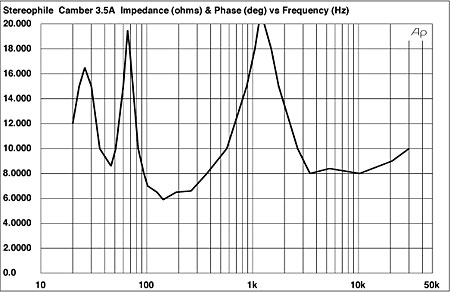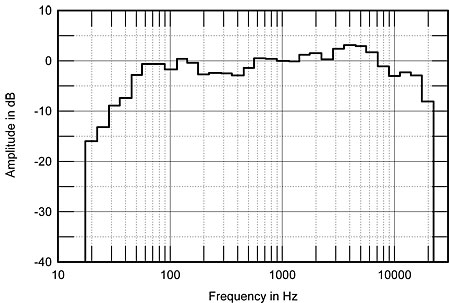| Columns Retired Columns & Blogs |
Plateau Camber 3.5 loudspeaker Measurements
Sidebar 2: Measurements
The frequency response of the Camber 3.5A was measured in the listening window—spatially averaged to minimize room standing-wave problems—using a 1/3-octave warble-tone generator; the nearfield low-frequency response of each speaker was also measured with a sinewave sweep to get an idea of the true bass extension relative to the level at 100Hz. The change of impedance with frequency and the voltage sensitivity (using 1/3-octave pink noise centered on 1kHz) were also measured.
The plot of impedance with frequency (fig.1) shows the characteristic pair of reflex humps in the bass, the port appearing to be tuned to 46Hz. The impedance is pretty benign, rarely falling below 8 ohms, meaning that in conjunction with the high sensitivity—my measurement was a little higher than spec at around 92dB/W/m at 1kHz—the 3.5 should be very easy to drive. The nearfield LF extension, measured midway between port and woofer, is dramatic, being 6dB down at 31Hz, but this promise is not kept in-room (fig.2), the response falling reasonably sharply below 50Hz. The bass appears to be a little underdamped, there being a slight rise in the nearfield around 63Hz.

Fig.1 Camber 3.5A, electrical impedance (2 ohms/vertical div.).

Fig.2 Camber 3.5A, spatially averaged, 1/3-octave response in JA's first Santa Fe listening room.
The midrange is smooth, though a rising trend is apparent from 200Hz to 4kHz, which may correlate with the propensity for upper-midrange hardness I heard. Another way of looking at the shape of the curve is to note that the lower mid octave, from 200–400Hz, appears a little shelved down, correlating with the lack of lower midrange heard, for example, with the cello. The top 1/3-octave of treble rolls off sharply in-room, particularly away from the tweeter axis, as is often the case with these largish dome tweeters. There is also a little too much energy apparent on-axis at 12.5kHz and 16kHz. While doing the measurements to produce this graph, I was struck by the excellent pair-matching—rarely more than 1dB difference between left and right—from the lower midrange upward, where the room effects will not be significant. This indicates good quality control both of the drivers and of the finished systems.—John Atkinson
- Log in or register to post comments




































